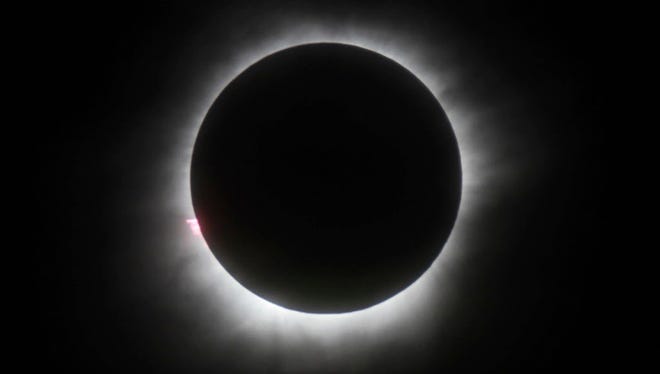Solar eclipse offers moon-walk moment: Science is all the rage
The spectacle will inspire bright young Americans to pursue science careers and, if we’re lucky, motivate our jaded leaders to support scientific research.

Thousands of people will leave home and work to chase Monday's solar eclipse. Tour groups are selling out; hotels are full along the path of totality. Why bother?
This eclipse doesn’t promise earth-shattering scientific discoveries. Despite passing over a huge swath of the country, it won’t intersect with any major solar observatories, such as the ones in California and New Mexico. It’s not a particularly long eclipse. There’s no Concorde aircraft flying along at supersonic speed, keeping up with the shadow of the moon as it passes across the Earth, as there was in 1973.
Yet this eclipse is worth the hype because of its power to inspire those who take the time to watch. It will go all the way across the country, and it’s the first eclipse to hit the lower 48 since 1979. That one only passed through Washington, Oregon, Idaho, Montana and North Dakota. For this one, the USA has a front-row seat, as perfect as you could want. Instead of flying to Uzbekistan or Norway to see the eclipse, you can just drive down the road to Wyoming or Kentucky.
More:Sherrod Brown on NAFTA talks: This time workers must be at the table
More:Trump administration's new threat to free speech
This eclipse will be seen by many more Americans than have ever seen an eclipse before. It will be spectacular, and the news media have lost no opportunity to remind the public that this is an experience not to be missed. The level of excitement is palpable and rising daily. There are even shortages of special eclipse-watching glasses.
Hundreds of thousands of people will witness a once-in-a-lifetime celestial event. What impact will it have on these multitudes? Hopefully, people witnessing this total solar eclipse will understand the value of scientific predictions. Even better, it can inspire bright young Americans to pursue careers in science — and, if we’re lucky, it can also motivate our jaded elected representatives to give scientific research the support it deserves.
Five decades ago, American eyes were also turned to the heavens. Then, as now, the news media offered non-stop coverage of a once-in-a-lifetime event. I remember where I was when a man first walked on the moon. If you are of an age, I bet you do, too. The space race triggered tremendous scientific discoveries, but even more important it exposed people to science. It inspired countless children to dream of being engineers who built rockets and mathematicians who calculated trajectories and astronauts who conducted experiments while weightless. I was one of them: The moon walk fueled my ambition to learn about science and, ultimately, become a scientist exploring the cosmos.

More:Trump champion: Bury Confederate romanticism. It's indefensible and bad for GOP.
POLICING THE USA: A look at race, justice, media
This solar eclipse will last only a few minutes, but those few minutes have the power to inspire. Ordinary people are learning about planetary orbits and the moon’s umbra and the sun’s corona. The news media are generating increasing excitement by including science stories at the top of the news hour. Science is suddenly all the rage. At least for a few days, the path of the eclipse means that children all across the country will be seeing science in action — they can even join in as citizen scientists and contribute to more than a dozen crowd-sourced science experiments.
We might not experience revolutionary science or mind-bending transformations, but this eclipse can and will make a difference. It will change lives. I guarantee that some of the young people watching it, with their minds open wide and wonder in their eyes, will be the scientists measuring the next eclipse that sweeps across America, in 2024.
Phil Nicholson is a Cornell University astronomy professor whose research focuses on planetary systems. He has been involved in the discovery of numerous outer satellites of Uranus, Saturn and Neptune; is a member of the Cassini mission team; and was the leader of a team studying the impact of comet Shoemaker-Levy 9 into Jupiter in 1994.
You can read diverse opinions from our Board of Contributors and other writers on the Opinion front page, on Twitter @USATOpinion and in our daily Opinion newsletter. To respond to a column, submit a comment to letters@usatoday.com.